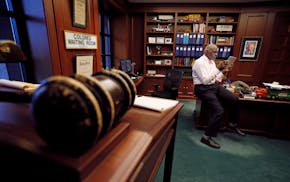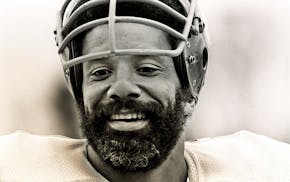Major college sports underwent another seismic shift Friday night when a federal judge in Oakland, Calif., gave final approval to the House v. NCAA settlement that brings on the distribution of billions of dollars — yes, billions with a 'B' — to past, current and future student-athletes.
Judge Claudia Wilken of the Northern District Court of California signaled during an April 7 hearing that she was close to giving final approval to the House settlement but had a key hang-up. She wanted a group of student-athletes who would lose their roster spots under the settlement to be grandfathered into the agreement.
She tasked the defendants — the NCAA and its major conferences — to produce a plan and report back. By Friday, the sides agreed to a compromise plan to temporarily exceed the roster limits.
"Despite some compromises, the settlement agreement nevertheless will result in extraordinary relief for members of the settlement classes," Wilken, a 75-year-old Minneapolis native who attended Derham Hall High School, wrote in the ruling. "… It would permit levels and types of student-athlete compensation that have never been permitted in the history of college sports, while also very generously compensating Division I student-athletes who suffered past harms."
Already, big-time college sports have been turned upside down in recent years with name, image and likeness (NIL) contracts that put money in athletes' pockets, plus the availability to switch schools seemingly at any time thanks to the transfer portal and its athlete-friendly rules. The House settlement now allows direct payments from the school to athletes.
"We welcome the opportunity to move forward in this new era of collegiate athletics," Gophers athletic director Mark Coyle said in a statement Saturday. "Minnesota is fully committed to participating in revenue sharing with student-athletes."
Here's a look at the House settlement and how it could impact collegiate sports:
What is the House settlement?
It's actually a settlement involving three antitrust cases — House v. NCAA, Hubbard v. NCAA and Carter v. NCAA — in which student-athletes sued the NCAA over either NIL compensation or amateur rules. The namesake figures in each are former Arizona State swimmer Grant House, former Oklahoma State running back Chuba Hubbard and former Duke defensive tackle DeWayne Carter.
Defendants — the NCAA and the five largest conferences (Big Ten, SEC, ACC, Big 12 and Pac-12) — and plaintiffs signed off on the settlement's terms in 2024. Wilken granted preliminary approval in October.
How much will athletes receive?
Here are the fun parts, which will apply to both current and former collegiate athletes:
• Division I schools can share up to $20.5 million of revenue per school annually with current athletes, with that amount increasing 4% each year under a 10-year deal. This will mark the first time that NCAA schools will use a formal revenue-sharing plan with athletes. Under the settlement, athletes still will not be considered employees. Each school that opts into revenue sharing, as Minnesota and all 18 Big Ten members have for the maximum $20.5 million, will determine how it wants to divvy up the funds among its programs.
• The NCAA will distribute $2.77 billion to former and current Division I athletes who competed from 2016 to '24. That back pay will be distributed over 10 years using a formula developed by sports economists. The more prominent the sport, conference and market, the more the athlete could make. High-profile football players could receive back pay of six figures, several national reports speculate.
What will it mean for the Gophers?
Coyle hasn't provided all the specific details of the Gophers' plan for its sharing of $20.5 million in revenue. But during men's basketball coach Niko Medved's introductory news conference on March 25, Coyle said it will be spread among athletes in five sports. He didn't name those sports, but multiple sources with knowledge of the situation told the Minnesota Star Tribune that athletes in football, men's basketball, women's basketball, men's hockey and volleyball will receive the funds.
Revenue-sharing models with other Big Ten and SEC schools show football taking priority, with 75% or more of the $20.5 million going to football players, a likely percentage for the Gophers. The Star Tribune reported that between revenue sharing and NIL money, Gophers officials envision $5 million to $6 million going to the men's basketball roster — which could mean a 15% allocation of revenue sharing (or $3.075 million) to that sport.
Of the remaining 10% — $2.5 million — 5% is expected to go to women's basketball, while men's hockey and volleyball would split the final 5%.
For Gophers football coach P.J. Fleck, key will be navigating how the settlement impacts his roster. He emphasized that the roles of Gerrit Chernoff, the team's general manager, and Marcus Hendrickson, director of player personnel, will become increasingly important in roster management under the settlement.
"That role is huge for us. All the roles are huge for us," Fleck said. "They're really good at what they do. It's a combined effort. It takes everybody."
Medved told the Star Tribune in April that the House settlement would bring order to a quickly changing situation.
"It's going to add some transparency and a little bit more rules of engagement for what we're doing," Medved said. "I don't think this is the end. I think this is a part of the evolution of where we're going here in the next three to four years."
He added: "I do think from a rev share perspective — being at Minnesota and in the Big Ten — that part of it will be very, very competitive for us," he said.
From where will the money come?
Money from TV contracts will play the primary role in paying athletes. For example, the Big Ten distributed about $63 million to 12 of its longest-standing member schools, which includes the Gophers, for fiscal year 2024, according to a report by The Athletic. That was up from roughly $60.5 million in fiscal year 2023.
In addition, schools will seek other revenue-generating sources, such as naming rights. On April 3, Minnesota announced it was partnering with a firm to explore selling the naming rights to Williams Arena. The move has the potential of raising $1 million annually, according to Navigate, a consulting firm in sports and entertainment.
When will the money start flowing?
For current athletes, the settlement will begin with the 2025-26 season, starting July 1. That's when payments can start.
The first payment for back damages to players from 2016-24 is expected within 45 days of finalization of the settlement.
What are the roster limits and scholarships?
Under the settlement, roster sizes of each sport will decrease, but more scholarships can be awarded. In the case of Division I football, the current average roster size of 128 will drop to 105. Current scholarship limits of 85 in football and 13 in basketball increase to 105 and 15, respectively. Schools are permitted but not required to award a scholarship to every athlete on their rosters.
Wilken objected to the fact that schools were trimming rosters to meet the limits imposed by the settlement. A compromise allows schools to temporarily exceed roster limits.
With the decrease in roster sizes and the increase in scholarships available, the number of walk-on athletes — those who join the program in hopes of eventually earning a scholarship — likely will decrease. It's a factor that will be determined by each program.
Will it still be the wild, wild West?
The freedom that athletes have received through the courts has resulted in NIL opportunities and the transfer portal creating perpetual free agency.
For example, Tennessee quarterback Nico Iamaleava, who reportedly received a four-year NIL deal that was to pay him $2.2 million this year, held out from spring practice.He wanted more money because the quarterback market had changed with former Georgia QB Carson Beck reportedly receiving $4 million this offseason to transfer to Miami (Fla.). The Volunteers moved on from Iamaleava, who helped Tennessee reach the College Football Playoff last year, and Iamaleava landed at UCLA.
Under the House settlement, athletes still can enter into NIL deals, though those that exceed $600 would be subject to review by an NIL panel to judge their legitimacy. The newly formed College Sports Commission will oversee NIL payments, and a clearinghouse platform from accounting giant Deloitte will streamline reviews.
Medved sees NIL contracts still being the most volatile aspect in the equation.
"The trick to all of it is figuring out the other piece," he said of NIL deals. "Now, what does NIL look like? It's not NIL right now. It's just more money to pay for play."
Where does Title IX fit in?
Don't be surprised if there are lawsuits over this issue since Title IX wasn't a driving part of the settlement. On Feb. 12, the Department of Education's Office of Civil Rights announced that Title IX would not apply to NIL payments, rescinding rules issued in the final days of the Biden administration that would have treated NIL payments like scholarships, requiring those to meet gender equity guidelines. For now, the new guidance means NIL payments will continue as allowed under the House settlement.

Twins lose second in a row to Blue Jays as bullpen falters late

The PWHL's growth comes with a price for a Minnesota Frost team building a potential dynasty
What is the 'House settlement,' and what does it mean for the Gophers and NCAA?

Souhan: Anxiety and depression in the NFL helped inspire Lindsey Young's children's book

